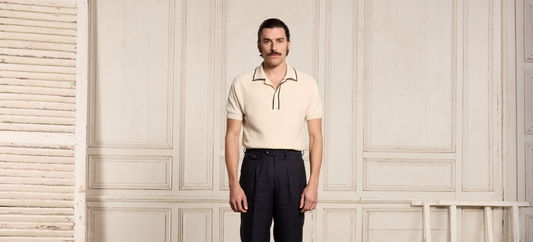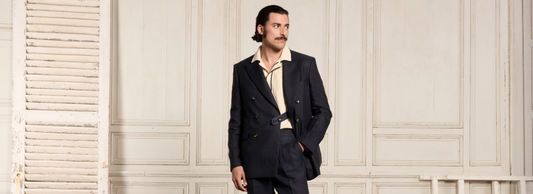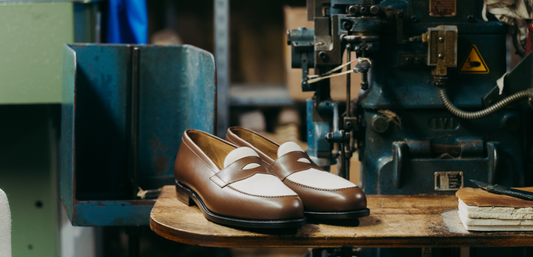What is the origin of the men's jacket? His history ? His evolution ? If the jacket gives the impression of escorting men since the dawn of time, it has only been two centuries since it has supported these gentlemen in its modern form. A true pillar of the classic men's wardrobe , we owe its diffusion - if not its emergence - to a certain George Bryan Brummell, "Beau" of his nickname. First of the dandies and arbiter of elegance under the English Regency, it is to him that we credit the replacement of the costume with the traditional ceremonial dress. The upper element of this now universal uniform, the jacket has continued to change since then, while remaining similar: a long-sleeved piece, buttoned at the front and open at the torso .
At Hast, whose primary vocation was to offer responsible shirts at the right price, the idea of designing a jacket quickly blossomed . And for good reason: history, like refined minds, struggles to imagine one without the other. Considering its roots, its evolution and its relationship with the shirt, we decided to include this sacred monster in our wardrobe; we developed the range with the application and humility that you know.
Respect for exceptional craftsmanship
If the authorship of the modern suit (and its associated jacket) goes to Beau Brummell, it would not be indecent to include the art of tailoring in the list of his descendants. In fact, Brummell's stylistic influence on a crown which was itself the most influential in the world at that time very widely disseminated a certain “science of tailoring”. Institutionalizing a new silhouette was not all: artisans around the world had to work to give it substance, taking a model from the masters of Savile Row. Thus, workshops sprouted up almost everywhere, tailoring men and boys for many decades, on a purely artisanal model.
It was only at the end of the Second World War, with the development of ready-to-wear (modeled on North American "ready-to-wear"), that handmade tailoring evaporated in favor of massive industrialized production .
Since then, several models have coexisted:
- ready-to-wear , which represents the vast majority of the market, offers jackets produced using standardized patterns and pre-selected materials.
- half-measure , which allows a standardized pattern to be adjusted to a customer's measurements to make their jacket.
- la Grande-Mesure (also called “Bespoke”) , which involves the creation of a personalized pattern to the customer's exact measurements, to develop a jacket perfectly fitted to their body shape and posture.
As you can imagine, the price increases from one option to another; and tailor-made which was once the norm is today only accessible to luxury customers . In any case, Hast approaches this legendary piece with great humility, aware of the differences between a ready-to-wear jacket and a large-scale artisanal creation. That said, the technical progress of the 21st century more than ever updates the recent adage: “ Good ready-to-wear is better than bad made-to-measure ”.
With the same rigor brought to the choice of our raw materials, the selection of our European partners, the accuracy of our cuts, the relevance of our color palettes and the responsibility of our production chain, we develop our jackets like our reference shirts and the rest: with care, honesty and passion.
The history of the jacket
Since its birth in the 1800s, the jacket as we know it has always preferred evolutions to revolutions. In this regard, the 20th century is particularly representative of this formidable power of mutation, between innovation and fidelity.
Before 1925, the jacket remained quite long , generally displayed 3 or 4 buttons, was satisfied with narrow and round shoulders and still sought the ideal place for its pockets.

The fashion designer Jean Patou in 1924
Until the Second World War, the silhouette became more structured : jackets became shorter, shoulders became more rigid and pockets fell inexorably to the bottom of the piece.

Official Fashion Bulletin, ca 1930
After the War, the time of rediscovered opulence marked the advent of stiff and almost “square” jackets : the shoulders were very broad, the waist not very marked, the lapels relatively wide and the buttons always double or triple.

Gregory Peck in “The Man in the Gray Suit”, 1956
Conversely, the 60s sounded the death knell for volume and thickness for jackets : they became shorter than ever before, the lapels became drastically thinner, the buttons were lowered, the waist was much more nipped in and the shoulders seemed reduced. A half.

Sean Connery as James Bond in “Goldfinger”, 1965
New turnaround in the 70's, of which you probably know the look which has become cult . The jackets are getting longer again , the lapels are widening considerably, the three buttons are disappearing and the marked shoulders are back in use. Above all, color and patterns make a most sensational entrance.

Sears brand lookbook, 1977
Closer to us, the 80s and their famous “ powersuit ” left their mark on an entire generation. Here, the trend is towards a generalized decline . Lapels, buttons, pockets, shoulders: they all seem to be suffering the full force of the effects of a newfound gravity after a decade spent in levitation.

Hardly caricatured, Leonardo Di Caprio's outfit in “The Wolf of Wall Street” illustrates this trend.
In the 90s, the lines became more balanced before returning, at the beginning of our century, to the fine and slim proportions of the 60's.
So goes fashion, cyclical and voracious, making yesterday's silhouettes the laughing stock of today... and the pride of tomorrow . However, the jacket is not one of those pieces that trends will have been able to swallow up. If its characteristics have evolved over time, its invariants have been able to resist the onslaught of current tastes. Eager to work on timeless pieces , we turned to them to work on our own jackets .
Anatomy of a jacket
The short chronology proposed above bears witness to this: the jacket has so far emerged victorious in its duel against the hourglass. And if the years have shaken up its design, none has managed to shake its initial structure . Since day one, the jacket has relied on stable elements that aesthetics and functionality have made impervious to the passage of time:
- two buttonable panels on the bust
- a V-shaped opening on the torso
- lapels on both sides of the collar
- long sleeves
- patch, piped or flap pockets
Of course, these constants have changed shape, size or thickness, but you will find that above all they have persisted.
In perpetual quest for the balance between tradition and modernity , we measure the preciousness of these markers of permanence at Hast. All pieces that have spanned the centuries have their own, and the jacket is no exception. In working with ours, we have therefore preserved them with the greatest care, incorporating everything that makes our wardrobe unique : exceptional natural materials , recognized European know-how and superior standards in terms of quality. traceability and accountability. The result ? Here it is.
Hast jackets
1° Our formal jackets
As their name suggests, our formal jackets are the dressiest in our wardrobe . Business-oriented, they are part of the purest tradition and feature all the details that have forged their legend.
You will easily recognize them by their subtly fitted cut , their smooth and sober material (wool, most often) and the different finishes inspired by the art of tailoring : notched lapels, natural shoulders, double back slits or even piped pockets with Rabat. Above all, these are jackets with which you will find matching pants, it being understood that they constitute the upper part of a two-piece suit.
NB: A tribute to the history of clothing and testimony to our unconditional love for the suit jacket, we wanted to include it in the capsule collection published for our 10th anniversary . Alongside other pieces that are symbolic and important to us (like the shirt and work jacket, for example), we have developed an absolutely unique crossover model. Made from super 110's wool and woven in Italy at Marzotto, it draws its inspiration from a fabulous Japanese bespoke jacket. Semi-canvass construction, pointed lapels, flap pockets, horn buttons, interior strap sewn into one panel: we have mobilized for the occasion the most beautiful materials and the most advanced know-how in ready-to-wear to develop a jacket that is in every way princely.

2° Our casual jackets
It's a fact: wearing a suit is no longer the norm for men. In a few years, the abolition of dress codes, the quest for comfort and new ways of working have relegated to second place that which had reigned supreme over men's clothing since the 19th century. However, the jacket managed to stand out by freeing itself from its pants to better experience its independence. Symbol of the very fashionable “ casual chic ”, the mismatched jacket brings a touch of elegance to an otherwise informal outfit.
At Hast, you will identify the latter by the richness of their material . More boldness, more texture, more relief, more grain: linen or cotton are worked here to bring the casual chic that our Italian friends call “ sprezzatura ”. A studied refinement, effortless, elegant almost involuntarily.
3° Our unstructured suit jackets
Faithful to our ambition to reinvent the classic men's wardrobe , in spring-summer we unveiled a series of unstructured suit-inspired jackets . Halfway between traditional clothing and our (beloved) work jackets , these daring models combine refinement , comfort and inventiveness .
The unstructured construction and magnificent notched lapel of the former are matched by the patch pockets and straight cut of the latter, placing our creations at the crossroads of two worlds united by the beauty of craftsmanship.
No question of dropping the jacket
An integral part of a two or three-piece suit, mismatched with jeans or chinos, formal or casual, straight or double-breasted, in wool, linen or cotton, rather straight or fitted, traditional or reinvented, the jacket has 1,001 faces, each more attractive than the other. At Hast, we wanted to integrate them all into our wardrobe, offering models suitable for all occasions . Wedding, office, weekend, our range extends from absolute classicism to completely contemporary freedom, to allow you to carry 200 years of history as if nothing had happened.
A word about maintenance
For a specific room, a specific wash. And because the jackets are uniquely delicate, only dry cleaning in the dry cleaners is possible. Regarding transport, we strongly advise you to invest in a protective cover : it will be very useful for taking your precious one on your next vacation, or simply for storing it for a season.











